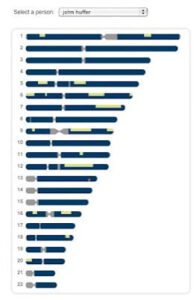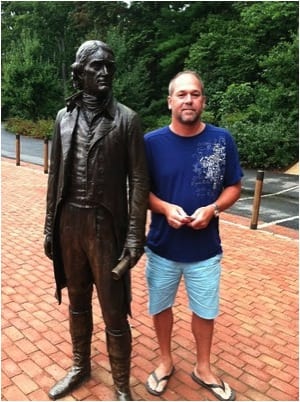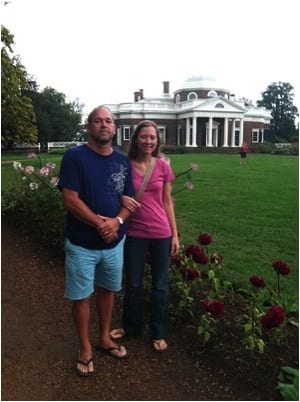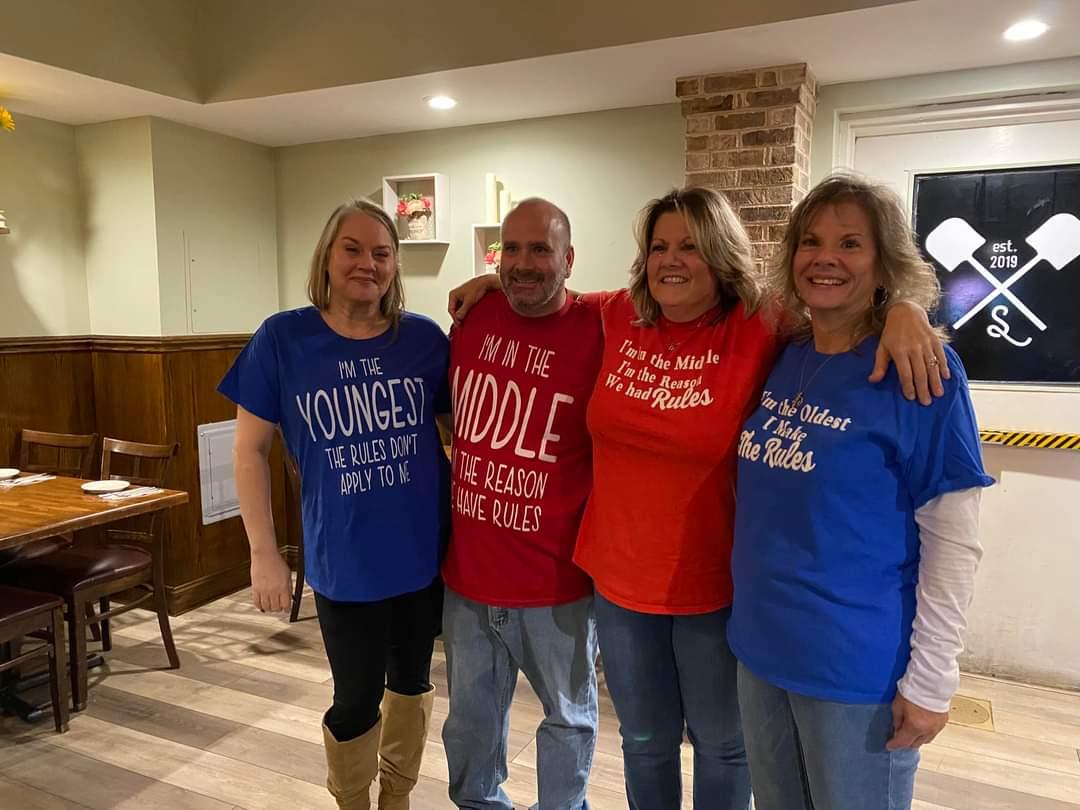As the series Finding Your Roots with Henry Louis Gates, Jr. begins its 10-week run on PBS, The Blog will feature posts from 23andMe’s Ancestry Ambassadors featuring their own stories about using DNA to dig into ancestry.
By CeCe Moore
You never know what a DNA test might reveal!
A few months ago, spurred on by my interest in genetic genealogy, my sister Erin decided to order a DNA test from 23andMe for my brother-in-law John Huffer. Since John has never known his father, we didn’t really know what his results would show. His mother’s family has a strong oral tradition of Native American ancestry, so we expected some mixed ancestry. However, what we found was completely unexpected.
Our Ancestry Ambassadors
 Ancestry Ambassadors from left to right, top row, Dr. Ann Turner, Larry Vick, Shannon Christmas, bottom row, Dr. Tim Janzen, Andrea Badger and CeCe Moore.
Ancestry Ambassadors from left to right, top row, Dr. Ann Turner, Larry Vick, Shannon Christmas, bottom row, Dr. Tim Janzen, Andrea Badger and CeCe Moore.
As the series Finding Your Roots with Henry Louis Gates, Jr. begins its 10-week run on PBS, The Blog will feature posts from 23andMe’s Ancestry Ambassadors. They’ll be writing about how they’ve used DNA to dig into the roots of their own families’ histories.
With our Ancestry Ambassadors, we’ve been lucky to bring together a group of people who are not just enthusiastic about ancestry, but who also have garnered a reputation in the 23andMe’s community of users as trusted sources and helpful guides.
We created our Ancestry Ambassadors group to help us build the best service possible. They’ve already helped, by spending a day and talking to our scientists, engineers and our CEO Anne Wojcicki offering ideas for improving 23andMe’s ancestry tools.
Members of the group – CeCe Moore, Dr. Tim Janzen, Dr. Ann Turner, Andrea Badger, Larry Vick and Shannon Christmas – also got a chance to learn a little bit more about 23andMe’s research mission.
Each member of the group had ideas about improving the overall experience of using 23andMe, including more voices from users. Opening up the blog to guests like our Ancestry Ambassadors is one way to do that.
His Ancestry Painting, in the image below, revealed that about five percent of his ancestry is African. 23andMe’s Ancestry Painting examines the 22 pairs of chromosomes one segment at a time and determines for each stretch whether it was most likely inherited from ancestors in Africa, Europe, or Asia and “paints” the segments based on that different ancestry.
I had never investigated John’s family tree before, but my curiosity was piqued. Fairly quickly it became obvious that his was no run-of-the-mill genealogy. John’s mother’s family traces straight back to Madison Hemings. That name may be familiar to you. Madison Hemings was the son of Sally Hemings, a mixed-race slave of Thomas Jefferson, our third president and author of the Declaration of Independence. My genealogy research clearly showed that Thomas Jefferson and Sally are John’s fourth great-grandparents!*
John has always especially admired Thomas Jefferson above all other historical figures and felt a special affinity to Monticello when he first visited there ten years ago, although he had absolutely no idea of his familial connection. When I first relayed my findings to John and my sister, they were, understandably, shocked. Once they started browsing the Internet in search of more information, they came across a very familiar photo on one of the websites about Monticello. An original of this very photo had hung in John’s house growing up. Further investigation shows that his mother had at least a vague knowledge of her family’s relationship to Thomas Jefferson and/or Sally Hemings, but did not pass it on to her children.
There have been a number of interesting “coincidences” involving the Huffers and Monticello that make one ponder on genetic memory. When John and my sister first visited Monticello on an anniversary trip ten years ago, they loved it so much that they decided to go back the very next year with their daughter Courtney.
 John Huffer’s Ancestry Painting. The green segments represent his African ancestry.
John Huffer’s Ancestry Painting. The green segments represent his African ancestry.
When Courtney entered the dining room of Monticello, she promptly passed out. Although her reaction could be attributed to the hot, humid day, it bears notice that this was the one and only time that Courtney has ever fainted. This was long before the family knew about their personal connection to the place or the families that lived there. Courtney says that although she felt “overwhelmed” at Monticello, she also “felt at home”. Recently, the family visited Monticello for the first time since discovering their relationship to it and its previous inhabitants. John and Courtney both said that Monticello “seems like a happy place” and gave them a sense of belonging.
Since John had never had any relationship with his father’s family and had very little contact with his mother’s side, he says it was as if they “had no history”. Erin relates, “It’s been fun for John to finally have a legacy of some sort, not to mention one as interesting as this,” and goes on to say that this discovery has finally given John and his siblings “a sense of who they are and where they came from.” John’s young nephew Joshua tells me that learning about his illustrious roots has inspired him to strive to make more of his life and given him the confidence that he can indeed achieve his ambitious goals.
 John Huffer at Monticello
John Huffer at Monticello
The discovery has been meaningful for John, once a fatherless little boy, who can now take comfort and pride in the knowledge that he is directly descended from one of the Founding Fathers of our country! During his most recent visit to Monticello, he couldn’t help but wonder if his deep love of Paris is simply a coincidence or caused by the same unknown spark that made Thomas Jefferson fall in love with it so long ago. Or, if his fascination with the art of brewing beer could have come from his forebearers, whom he learned on his visit were expert brewers at Monticello. It is wonderful for John and his family to finally have these types of questions about their ancestry to ponder; questions that most of us take for granted.
DNA testing has come full circle for genetic genealogy with John’s story. It is fitting that one of the very first public uses of DNA for genealogical purposes was the Y-DNA test in 1998 that originally addressed the controversy surrounding the paternity of Sally Hemings’ children. Today, more than a decade later, the simple decision to test with 23andMe is what led John to make this illuminating discovery about his roots.
 John and Courtney Huffer, descendants of Thomas Jefferson at Monticello
John and Courtney Huffer, descendants of Thomas Jefferson at Monticello
[*Although some Jefferson researchers had disputed the validity of the claims that Sally’s children were fathered by Thomas Jefferson, most of these doubts were put to rest after a 1998 Y-DNA test on Sally’s son Eston’s direct male line descendants proved that they carry the Y chromosome of Thomas Jefferson’s male line. Although Madison has no living direct line male descendants who could have their Y-Chromosome DNA tested to further support this claim, it is now widely accepted that Thomas Jefferson fathered all of Sally’s children. This is supported by oral histories of Sally’s descendants and analysis of the couple’s relationship and time spent together. Annette Gordon-Reed provides a detailed look at this evidence in her exhaustive study and Pulitzer Prize winning book, “The Hemingses of Monticello”. The official Jefferson Monticello website also addresses this issue. John’s discovery has sparked my interest in this fascinating subject. As a result, I am spearheading an autosomal DNA project on the descendants of Sally Hemings. Although it is now generally recognized that Thomas Jefferson fathered all of Sally Hemings’ children, it has been impossible to determine with certainty. The introduction of autosomal DNA testing has changed this. Through autosomal DNA testing of specific individuals, I hope to be able to demonstrate that the descendants of Sally Hemings share blocks of DNA with Jefferson’s “legitimate” descendants. If it is not possible to procure DNA from any of these known descendants, I will seek DNA from descendants of individuals one step further back in Thomas Jefferson’s pedigree in an attempt to show that Sally’s descendants possess DNA from Jefferson’s ancestral lines. Since autosomal DNA undergoes random recombination with each successive generation, it will be necessary to test the oldest living descendants of these lines. DNA is the perfect tool for this because it does not harbor any prejudice or predetermined notions. Anyone who fits these parameters should contact me at yourgeneticgenealogist@gmail.com.]
23andMe provides genetic testing services for informational purposes; your results may or may not help you to search for or identify relatives or family members.

CeCe Moore is a genetic genealogist specializing in the use of autosomal DNA for genealogy. She writes the popular blog Your Genetic Genealogist and works as a television producer with StudioINTV. CeCe is the Southern California Regional Coordinator for the International Society of Genetic Genealogy (ISOGG) and a member of Mensa. Her favorite genetic experiment is her seven-year-old son, Nicolas.



